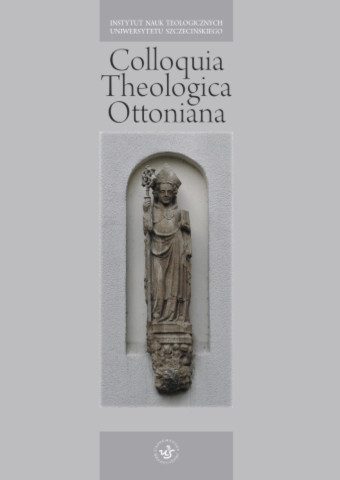
ISSN: 1731-0555
eISSN: 2353-2998
OAI
DOI: 10.18276/cto.2018.1-05




Issue archive /
1/2018
Historia i teologia czwartej ewangelii w świetle "Żydów" Janowych
(History and theologi of the fourth gospel in the light of Jahannine "Jews")
| Authors: |
Stanisław
Wróbel
Wydział Teologii Katolickiego Uniwersytetu Lubelskiego |
| Keywords: | Jews Gospel of John History Theology Polemic |
| Data publikacji całości: | 2018 |
| Page range: | 39 (107-145) |
Abstract
In the present article the term “Jews” is shown as the interpretative key for the better understanding of history and theology of the Gospel of John. First the author makes analysis of the term “Jews” in the wider context of Jewish sources (Old Testament, Qumran texts, rabbinic literature, Josephus Flavius and Philon of Alexandria) and Christian sources (New Testament, patristic literature). Then the author describes the specific meaning of the term “Jews” which occurs 72 times in the Fourth Gospel. He distinguishes various meanings if this term (regional, general, ethnic and religious). He is especially interested in the negative use of this term in 37 texts of the Gospel of John. Connecting diachronical and synchronical methods in the interpretation of the term “Jews” he tries to answer on the questions: who are the Johannine “Jews”? and how is the function of the term “Jews” in the narrative of John? He makes analysis in historical, sociological, symbolical, narrative and psychological interpretation. On the basis of wide analysis of the Johannine “Jews” the author shows its important meaning for better understanding of historical and theological context of the Fourth Gospel.
Download file
Article file
Bibliography
| 1. | Ashton J., The Identity and Function of the Ioudaioi in the Fourth Gospel, „Novum Testamentum” 27 (1985), s. 40–75. |
| 2. | Caron G., Qui sont les ‘Juifs’ de l’évangile de Jean?, Ottawa 1997. |
| 3. | Cebulj C., Ich bin es. Studien zur Identitätsbildung im Johannesevangelium, Stuttgart 2000. |
| 4. | Charlesworth J.H., The Priority of John? Reflections on the Essens and the First Edition of John, w: Für und wider die Priorität des Johannesevangelium, red. P.L. Hofrichter, Hildesheim–New York 2002, s. 73–114. |
| 5. | Chrostowski W., Jesus Christ in the Eyes of Jews and Judaism, „Collectanea Theologica” 71 (2001), s. 101–113. |
| 6. | Chrostowski W., Trzecia świątynia w Jerozolimie i inne studia, Warszawa 2012. |
| 7. | Chrześcijaństwo a judaizm rabiniczny. Historia początków oraz wczesnego rozwoju, red. H. Schanks, tłum. W. Chrostowski, Warszawa 2013. |
| 8. | Devillers L., La fête de l’Envoyé. La section johannique de la fête des Tentes (Jean 7,1–10, 21) et la christologie, Paris 2002. |
| 9. | Katz S.T., Issues in the Separation of Judaism and Christianity after 70 C.E., „Journal of Biblical Literature” 103 (1984), s. 43–76. |
| 10. | Kuśmirek A., Żydzi w Ewangelii Jana, „Studia Theologica Varsaviensia” 30 (1992), nr 2, s. 121–135. |
| 11. | Langkammer H., Żydzi w Nowym Testamencie, „Ateneum Kapłańskie” 486 (1990), s. 183–191. |
| 12. | Marcus J., Birkat ha-Minim Revisited, „New Testament Studies” 55 (2009), s. 523–555. |
| 13. | Martyn J.L., History and Theology in the Fourth Gospel, New York 1968. |
| 14. | Mędala S., Funkcja chrystologiczno-eklezjologiczna dialogów Jezusa z Żydami w czwartej Ewangelii, Warszawa 1984. |
| 15. | Mędala S., Funkcja „«Żydów” w Ewangelii św. Jana, „Collectanea Theologica” 64 (1994), nr 2, s. 79–101. |
| 16. | Mędala S., Ewangelia według św. Jana 1–12. Wstęp – przekład z oryginału – komentarz, (Nowy Komentarz Biblijny, t. 4.1), Częstochowa 2010. |
| 17. | Mędala S., Ewangelia według św. Jana 13–21. Wstęp – przekład z oryginału – komentarz, (Nowy Komentarz Biblijny, t. 4.2), Częstochowa 2010. |
| 18. | Nodet É., Taylor J., Essai sur les origins du christianisme, Paris 1998 |
| 19. | Rosik M., Zarzewie konfliktu między Kościołem a Synagogą (do 135 roku), w: Jezus i chrześcijanie w źródłach rabinicznych: Perspektywa historyczna, społeczna, religijna i dialogowa, red. K. Pilarczyk, A. Mrozek, „Estetyka i Krytyka” 3 (2012), nr 27, s. 69–103. |
| 20. | Rosik M., Kościół a Synagoga (30–313 po Chr.). Na rozdrożu, Wrocław 2016. |
| 21. | Studies in Rabbinic Judaism and Early Christianity. Text and Context, red. D. Jaffé, Leiden 2010. |
| 22. | Szefler P., Żydzi, w: Egzegeza Ewangelii św. Jana, red. F. Gryglewicz, Lublin 1992. |
| 23. | Teppler Y.Y., Birkat ha-Minim, Tübingen 2007. |
| 24. | Vana L., La birkat ha-minim è una preghiera contro i giudeo-cristiani?, w: Verus Israel. Nuove prospettive sul giudeocristianesimo, red. N. Belayche, Brescia 2001, s. 147–189. |
| 25. | Wróbel M.S., Synagoga a rodzący się Kościół, Kielce 2002. |
| 26. | Wróbel M.S., Kim jest avnqrwpokto,noj w J 8,44?, „Roczniki Teologiczno-Kanoniczne KUL” 49 (2002), s. 77–92. |
| 27. | Wróbel M.S., Antyjudaizm a Ewangelia według św. Jana. Nowe spojrzenie na relację czwartej Ewangelii do judaizmu, Lublin 2005. |
| 28. | Wróbel M.S., Who are the father and his children in Jn 8:44? The literary, historical and theological analysis of Jn 8:44 and its context, Paris 2005. |
| 29. | Wróbel M.S., Jezus i Jego wyznawcy w Talmudzie. Analiza tekstologiczna, historyczna i socjologiczna, Lublin 2013. |
| 30. | Wróbel M.S., Motywy i formy żydowskich prześladowań pierwotnego Kościoła (I–II w. po Chr.), „The Biblical Annals” 3 (2013), z. 2, s. 421–438. |